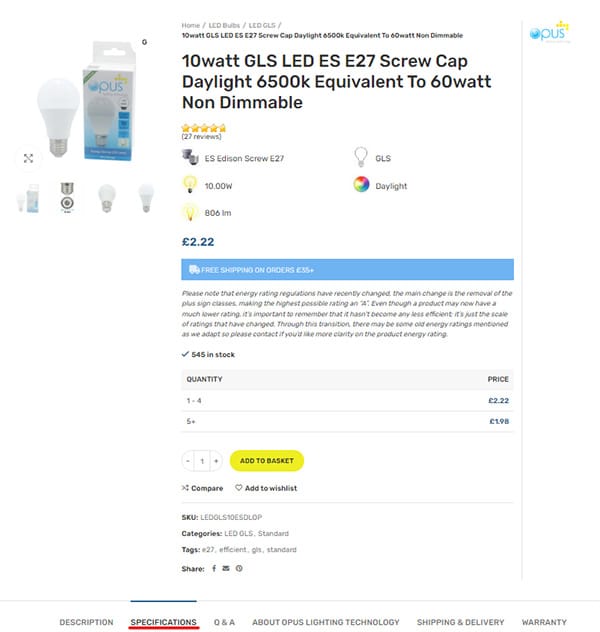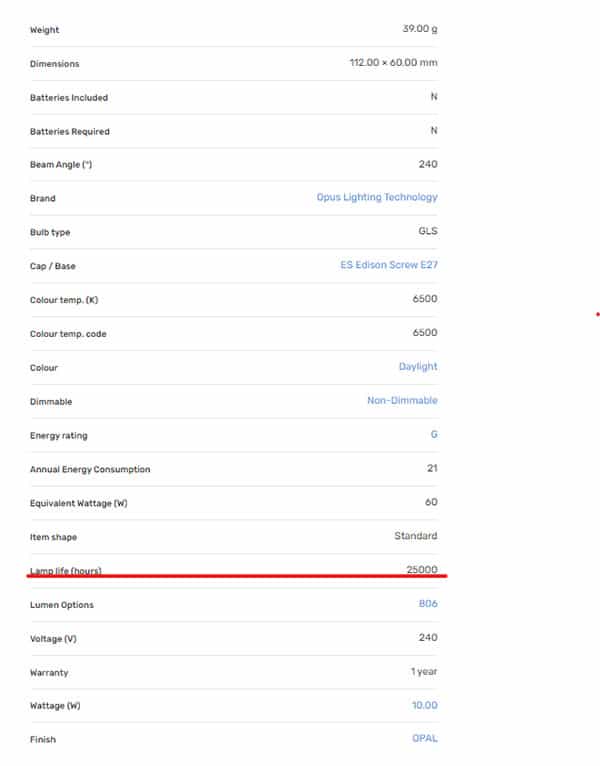Discrete or Continuous Number of Lightbulb That Can Burn Out in a Week
Lightbulbs have varying life time hours depending on brand, technology and type. The lifespan of a bulb is quoted in several different ways; Incandescent, Halogen and Fluorescent are quoted as average rated life (ARL) also known as B50, and LED are quoted as L70, L80 and L90. So, how are both life time hours worked out?
Average rated life (ARL) or B50 indicates how long it takes for 50 percent of the lightbulbs in a test batch to fail. If the average rated life is 1,000 hours, 50 percent of the lightbulbs would have been expected to fail at this point.
L70, L80 and L90 indicates how much of the of the initial light/lumen output the product is expected to emit at the stated hours. For instance, if the L70 life time hours are stated at 25,000 hours, the light source will emit 70 percent of the initial light output upon reaching this time, L80 would be 80 percent and L90 would be 90 percent.
Another important aspect to take into consideration is that all light bulb ratings are carried out under perfect laboratory conditions. There are numerous other factors that will determine the life of any light bulb. Electrical surges, extreme cold, vibration and extreme heat are just a few examples of instances where the life time hours of the product will be affected. Any number of factors could determine the performance and ultimately the life of a light bulb.
How to determine average rated life time hours
Our online bulb shop makes it easy to determine the life time hours for any bulb. Here's how:
- To find the life time hours, scroll down below the light bulb image for the product you have selected. Here, we have selected a 10watt LED GLS with an E27 screw cap.
- Below the light bulb you will see a tab labelled "Specifications", click on it.

- After clicking on "Specifications", you will see detailed information about the product. To find out the life time hours, scroll down to Lamp Life (hours), the life time hours will be listed to the right.

How long do light bulbs last?
Incandescent bulbs generally, have the shortest lifespans. The average incandescent bulb light span is approximately 1,000 hours.
Fluorescents are a long-lasting option, running for anywhere from 15,000 to upwards of 20,000 hours. They are best used in places where they will be left on for consistent periods of time, such as offices or popular areas of the home like the kitchen.
CFLs take a moment to warm up and achieve full brightness, but they can go a long time between replacements, typically lasting between 8,000 and 20,000 hours.
Halogen bulbs are a more efficient alternative to incandescent, but still have a relatively short life span of on average 2,000 hours.
LEDs are the longest-lasting light bulbs, lasting for years longer than their counterparts, with lifespans of up to 50,000 hours. They come in a variety of styles, shades, and shapes, making them the ideal energy-efficient and enduring option.
How to make your light bulbs last longer
Follow these two suggestions to extend the average lifespan of your light bulbs:
1. Buy the right bulb for the job
Some bulbs are specially designed to withstand the unique conditions of particular placements, such as outdoors or inside appliances. In most cases, an "incorrect" light bulb will still operate, but its lifespan and performance will decrease and a replacement will likely be required sooner than expected.
There are a few key places where you should use specially marked bulbs, such as:
- Outdoors
- Dimmers
- Appliances
- Closed fixtures
Check out our selection of appliance bulbs:
www.thelightbulb.co.uk/home-garden/appliance-oven/
Incandescent and Halogen Bulbs
With bulbs like halogen and incandescent, it's important to pick the right product for the task because a hot filament can be easily damaged by vibrations and may eventually snap. For example, appliance bulbs come with reinforced filaments so they can stand up to the extra strain, which keeps your oven or refrigerator brightly lit for as long as possible no matter how many times you open and shut the door. For ovens a heat resistant bulb must be used, to withstand the extreme heat.
Check out our selection of appliance bulbs:
You should only handle this type of lighting, when they are at room temperature. Incandescent and halogen bulbs have filaments that warm up quickly, which is beneficial for lighting a room, but the heat makes the filament brittle. Because of this, moving a filament light bulb while it's hot increases the likelihood that the filament will be damaged. The more you move an incandescent or halogen bulb while it is warm, the greater the risk that the filament will snap, resulting in a prematurely burnt-out bulb. To limit damage to your filament bulbs and increase their lifespan, make sure you only move them after they've have had time to cool down after being turned off. The golden rule for incandescent and halogen bulbs
Fluorescents and CFLs
These bulbs should only be used in places where they will be turned on for longer than 15 minutes, as they are not built or tested to be turned off and on frequently.
LEDs
Dimmable bulbs are the most commonly encountered special case for LEDs. If you are going to use LEDs with a dimmer, make sure they are dimmable bulbs and you are using an LED compatible dimmer. A non-dimmable LED bulb may function with a dimmer, but often at the detriment of its lifespan and performance – non-dimmable LED bulbs are prone to flickering and can emit a high-pitched noise when used with dimmers. Take a look at these dimmable LEDs:
2. Use bulbs effectively & efficiently
Turning your lights on takes the bulb from 0 to 100 in seconds, flooding it with electricity that can, in some cases, gradually weaken parts of the light bulb. This is part of the typical wear and tear on light bulbs, but there are ways to limit the amount of stress, thereby increasing light bulb lifespan.
Keep the Lights On: Fluorescent, CFLs, and HID lamps are impacted by on/off cycles more significantly than other types of bulbs. Frequently turning them on and off or regularly leaving them on for less than 5 minutes can decrease the lifespan of these bulbs. As such, it's best to use these bulbs in places where they will be left on for longer periods of time.
Find the perfect bulb
Our service team can help you find a bulb that will last.
If you have any questions about average rated life time hours, our expert service team can help you find the perfect bulb for your space. Call us at 01869 362222, email, or for instant expert advice use, our live chat.
What to Read Next
Source: https://www.thelightbulb.co.uk/resources/light_bulb_average_rated_life_time_hours/
Post a Comment for "Discrete or Continuous Number of Lightbulb That Can Burn Out in a Week"